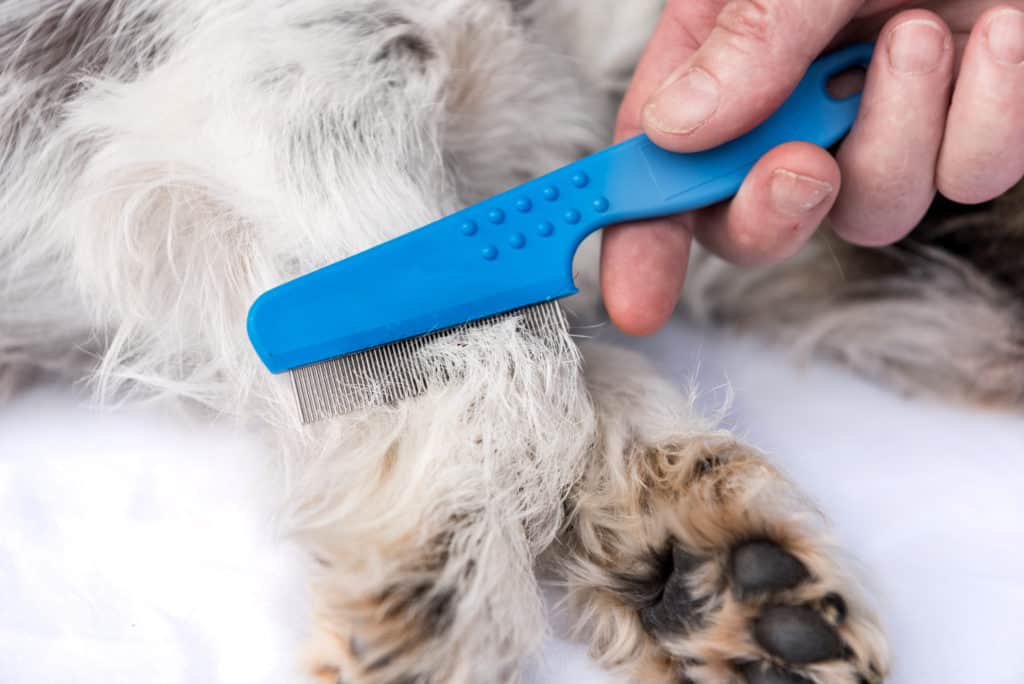Pets and Pest Control – Part 1
Pets and Pest Control – Part 1
Unfortunately, just as pest infestations affect us, they can affect our beloved pets as well, and in most cases where pests and pets interact, there are notable health risks to your furry friends. Luckily, with a bit of vigilance, you can either quickly treat, or avoid these concerns altogether.
In this blog, we discuss infestations of TICKS AND FLEAS, the various health risks they pose to your furry friends, and ways you can help avoid these pet-pest problems.

Fleas
This pest is typically the first one that comes to mind for people when considering pests and pets. Typically, fleas are brought into the home via fido or fluffy. They are ectoparasites (ie. external parasites – living and feeding outside of their host) that particularly love to feast on the blood of our furry friends. In total, there are roughly 2,500 different subspecies of fleas, the most prominent of which is the Ctenocephalides felis in the United States. While this scientific term translates to “cat flea,” it is actually a bit of a misnomer as these fleas far more commonly infect dogs.
Luckily, most pet encounters with fleas result in more mild health problems as opposed to severe. Most commonly, pets will start showing signs of an immune response known as flea allergy dermatitis (FAD). This condition is marked by intense itchiness, rashes, redness, and overall skin irritation, and is caused by the saliva that fleas inject into the dermis of their victims with each bite. While FAD is the most common immune reaction to the saliva, a far more serious condition can occur when exposed to various flea bites over a short period of time: anemia. If your pet is developing anemia, you may notice increased lethargy, labored and/or rapid breathing, and weakness – all signs that your furry friend requires immediate medical intervention. If left untreated, this flea-induced condition can unfortunately even lead to death.
Oddly enough, these external parasites can actually lead to internal parasites for your pets as well. While somewhat uncommon, fleas can be internally infested with the eggs of tapeworms. If your unsuspecting dog or cat reacts to the itchy bite of these insects and nips or licks the area to try and sooth the itch, they may accidentally ingest the infected flea. Once the eggs enter digestive system of your pet, they begin to hatch and immediately start latching on to the intestinal lining of your furry friend. This internal infestation can cause weight loss, changes in appetite, discomfort, vomiting, irregular bowel excretions, and diarrhea. Luckily, these additional parasites are very easily treated by a veterinarian and routine pest control can greatly reduce the risk of your pets ever having these flea-related problems.

Ticks
Ticks are another infamous ectoparasite that tends to plague pets just as much as they plague humans. These sneaky arachnids require blood meals in order to survive and will bury their heads into the skin of their victims in order to feed. The saliva of ticks contains a local anesthetic, numbing the area and rarely causing any discernable discomfort. As such, the best way to determine your pet has a tick is by doing a thorough inspection following any excursions in areas where ticks may be present (ie. tall grass, areas of dense foliage, forests, etc.).
Unfortunately, these pests pose very serious health risks for both humans and pests. No matter what stage of their life cycle that a tick is in, if it is infected with disease, it is able to spread the pathogens onto a new victim. Ticks are notorious vessels of Lyme disease, which can be extremely detrimental to both humans and pets, and they can also cause blood loss, anemia, skin irritation, infection, or even tick paralysis if a tick is left feeding for a long enough time. In other serious cases, ticks can also pass a lethal infection to your furry friends called Cytauxzoonosis. Signs of this rapidly progressing and fatal infection include: high fever, loss of appetite, respiratory distress, jaundice, coma, and death. As such, it is incredibly important to monitor your pets for ticks whenever they may have come into contact with these dangerous pests, and take steps to remove them as soon as possible.
When removing ticks from both humans and pets, technique is extremely important as incorrect removal can result in the head and mouth of the tick remaining underneath the surface of the skin, causing infections, rash, and other complications. Improper handling can also cause the fluids of the tick to be injected into your furry friend, greatly increasing the risk of becoming infected with tick-borne diseases. Other mistakes to avoid include: using fire to “burn the tick off,” attempting to smother the tick with Vaseline, and handling the tick with your bare hands, as it can easily leave some of its infectious fluids on your skin, putting you at risk of various diseases.
Try following these 5 Simple Steps to rid your furry friend of these parasites both quickly and safely:
- Get Help if Possible – Tick removal is easier with at least two people – one to hold your pet still, and the other to conduct the actual removal.
- Use Proper Tick-Removal Tools – If possible, use a tool designed for tick removal. If this is unavailable tweezers are a great substitution. Also, be sure to wear gloves to protect yourself.
- Clean the Wound – Using soapy water, gently clean the area once the tick is removed.
- Keep the Tick – As odd as this sounds, it can be crucial for disease identification should your pet fall ill. If possible, try to store the tick in a bit of Tupperware or other tightly sealed container which could be brought to your veterinarian in the case of an onset of symptoms.
- Keep an Eye on Fido/Fluffy – It is important to be aware of any changes in behavior or appetite, or any other concerning symptoms that may show within the following two to three weeks as this can be indicative of tick-borne diseases. In the unfortunate case this occurs, be sure to bring your furry friend to your veterinarian as soon as possible for treatment.

Prevention
Luckily, there are various preventative treatments for both cats and dogs to avoid these pests. Products like Frontline Plus, K9 Advantix, and more all provide protection for pets against both fleas and ticks. Talking with your veterinarian can help you select the best preventative products for you and your furry friends.
But, aside from topical and ingestible treatments for your pets you can take further measures to protect your home from both of these parasites. Our routine Mosquito Treatments include protection against fleas and ticks around your home, removing the risk of both you or your pets picking up one of these creepy crawlies in the comfort of your own yard.
If more information on how we can help you stay safe from fleas and ticks, call us today.

Citations
11 Bugs to Watch Out For If You Have Pets (2017) American Pest. Available at: https://www.americanpest.net/blog/post/11-bugs-to-watch-out-for-if-you-have-pets (Accessed: September 2020).
Dr. Nicholas, J. (2019) How to Remove a Tick from Your Dog or Cat – What to Do and What NOT to Do, Preventive Vet. Available at: https://www.preventivevet.com/dogs/how-to-remove-a-tick-from-your-dog-or-cat (Accessed: June 2020).
Fleas and Ticks (no date) ASPCA. Available at: https://www.aspca.org/pet-care/general-pet-care/fleas-and-ticks (Accessed: February 23, 2021).
The Hidden Dangers of Flea Bites: What to Look For (no date) The Associated Press. Seresto. Available at: https://apnews.com/sponsored/?prx_t=z40EAq48yAniAPA&prx_ro=s&ntv_fpc=671dc30c-79c6-4e77-b41f-040c722e9642&ntv_fr (Accessed: September 2020).
Hill, C. and MacDonald, J. (2008) Fleas, Purdue University . Purdue’s College of Agriculture: Entomology Department. Available at: https://extension.entm.purdue.edu/publichealth/insects/flea.html (Accessed: September 2020).
Preventing Ticks on Your Pets (2019) Centers for Disease Control and Prevention. The National Center for Emerging and Zoonotic Infectious Diseases and the Division of Vector-Borne Diseases. Available at: https://www.cdc.gov/ticks/avoid/on_pets.html (Accessed: February 23, 2021).
Tapeworms in Cats 101 (2020) Chewy Pet Central. Available at: https://petcentral.chewy.com/tapeworms-in-cats/ (Accessed: September 2020).
Ticks and Tick Removal (2018) International Cat Care. Available at: https://icatcare.org/adive/ticks-and-tick-removal/(Accessed: June 2020).
Why Do We See So Many Pests in the Fall?
Why Do We See So Many Pests in the Fall? Why Do We See So Many Pests in the Fall? Summary: Fall’s cooler [...]
Why German Cockroaches are Such Problem Pests (And How to Get Rid of Them)
Why German Cockroaches are Such Problem Pests (And How to Get Rid of Them) Why German Cockroaches are Such Problem Pests (And How to Get [...]
Summer is Ending, But Pests are Still Going Strong
Summer is Ending, But Pests are Still Going Strong Summer is Ending, But Pests are Still Going Strong Summary: Summer is coming to [...]
10 Tips for Going Back to School Pest-Free
10 Tips for Going Back to School Pest-Free 10 Tips for Going Back to School Pest-Free Summary: The school year is a busy [...]
What is Bug Spray, Really?
What is Bug Spray, Really? What is Bug Spray, Really? Summary: Bug spray is a great tool for preventing pests during outdoor activities, [...]
The Various Personalities of Stinging Pests
The Various Personalities of 5 Stinging Pests The Various Personalities of 5 Stinging Pests Summary: Stinging insects are among the most common summer [...]

